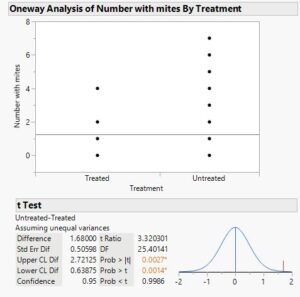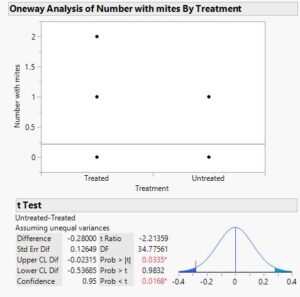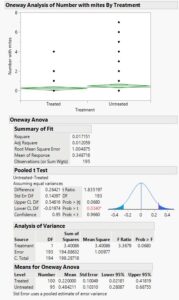Final report for ONE21-406
Project Information
The eriophyid mite Aceria tulipiae, commonly known as dry bulb mite, has been documented in garlic crops in the United States since 1938 and is considered the main pest in garlic in all production areas around the world, causing average losses of 23%. We have been documenting dry bulb mite damage since 2017 in New York, 2016 in Massachusetts, and most recently in Maryland. Dry bulb mites can cause significant damage to garlic crops in storage and in the subsequent growing season. In storage each generation takes just 8-10 days to develop at room temperature. Damage in storage presents as shriveled cloves and increased secondary disease incidence. Heavily infested garlic that is replanted may die from secondary diseases over the winter or may emerge with stunted, twisted, and yellowed foliage resembling viral infection. Garlic often grows through minor infections but may harbor enough mites through the season to start the cycle again in storage.
This project sought to evaluate the effectiveness of the predatory mite Stratiolaelaps at controlling populations of dry bulb mite Aceria tulipae in garlic in a variety of different storage environments.
This project was implemented on four commercial garlic seed farms, each of which provided a complete picture of their mite management strategies through self reporting of conditions in both drying and storage environments. The farms we partnered with are geographically diverse, located from eastern NY through VT, and used different cultural practices for drying and storage.
Shortly after curing was completed at each farm 5 organza sample bags containing 10 bulbs had Stratiolaelaps predatory mites and their media applied at a rate of 1 liter per 1000 square feet and were sealed. These bags, along with 5 sample bags with 10 untreated bulbs, were placed into storage until the first week of October. At this point all garlic was mailed to Philia Farm for initial assessment. Samples were held until January, when damage from mites was detected on some garlic. At this point subsamples were collected and assessed for mite damage, which was measured by presence or absence on each clove.
Each of the sites where mites were detected was analyzed using a paired t-test to examine effectiveness of the experimental treatment. At each site, each bag is a separate replication, and the 5 individual bulbs are samples while cloves are subsamples. Data from the five sites were also analyzed using an Analysis of Variance.
Of the four farms involved in the study, two never developed any mite populations. Philia Farm and Dig Acres both developed mite populations, with Dig having a significant mite population and Philia a much more modest population. The paired t-test for Philia showed a significant difference between treated and untreated (p=.03) with more cloves being infested in the treated. Dig Acres t-test also showed a very significant difference between treated and untreated (p<.01) with untreated cloves having more mites than treated cloves. An Analysis of Variance (ANOVA) across all farms did not show a significant difference between treated and untreated garlic (P=.07, slightly/weakly significant).
My preliminary explanation for this discrepancy is that I suspect that the Dig Acres garlic had a larger mite population earlier in storage than the Philia garlic, and that this population kept the predatory mites alive and feeding for longer. If the initial Philia mite population was too low, the predatory mites could have died off prior to A. tulipae populations increasing to a detectable level.
This preliminary explanation is based on the observation that mite levels in the Dig Acres garlic were significantly higher during data collection than the levels in the Philia garlic. Assuming that reproduction rates were similar in the two populations, mites should have reached detectable levels earlier to reach the levels observed in January.
The most important observation from these trials was that, as is often the case, use of biological controls is complicated. The complications with this project begin with the observation that mite levels are generally low enough when garlic enters storage that producers may not be able to find any at all, even if enough are present to eventually cause an outbreak. Detection may require extensive destructive sampling since mites reside on the inside of the wrapper leaves. This leaves growers having to decide whether to make a relatively costly application without knowing if they have a problem.
This study did not lead us to definitively recommend predatory mites for control of A. tulipae in garlic during storage, but it has made it clear that additional research on timing of applications and ways to establish thresholds for applications are warranted. Outreach for this project was primarily written and focused on emphasizing a multilayered approach to A. tulipae management which includes application of heat during the curing process, varietal selection, and careful monitoring.
This project seeks to evaluate the effectiveness of the predatory mite Stratiolaelaps at controlling populations of dry bulb mite Aceria tulipae in garlic in a variety of different storage environments. By choosing five commercial garlic farms with different drying and storage conditions we hope to find the ideal range of conditions to allow Stratiolaelaps to maintain viability for long-term A. tulipae control while also keeping damage below environmental thresholds.
Additional work is needed in refining the timing of Stratiolaeps applications prior to advocating for widespread adoption of this control measure.
The eriophyid mite Aceria tulipiae, commonly known as dry bulb mite, has been documented in garlic crops in the United States since 1938 (Keifer 1938) and is considered the main pest in garlic in all production areas around the world, causing average losses of 23% (Larrain 1986). We have been documenting dry bulb mite damage since 2017 in New York (Stewart 2017), 2016 in Massachusetts (Madieras 2016) and most recently in Maryland (Brust 2021). Based on discussion with pathologists and extension educators throughout the region during our 2020 weekly pest calls it is assumed that dry bulb mites are a widespread problem throughout the Northeast.
Dry bulb mites can cause significant damage to garlic crops in storage and in the subsequent growing season. In storage each generation takes just 8-10 days to develop at room temperature (Courtin et al, 2000). Damage in storage presents as shriveled cloves and increased secondary disease incidence. Heavily infested garlic that is replanted may die from secondary diseases over the winter or may emerge with stunted, twisted, and yellowed foliage resembling viral infection. Garlic often grows through minor infections but may harbor enough mites through the season to start the cycle again in storage.
Work is ongoing to determine organic and conventional treatments that suppress mites from planting through the growing season through an NYSCBG project. An ongoing SARE-funded post-harvest study (ONE-19-351) is examining the effects that drying and storage temperature and relative humidity have on post-harvest diseases and eriophyid mite infestations. The final piece of the puzzle is to determine whether it is possible to combat mite infestations in storage using biological controls. We specifically propose deploying Stratiolaelaps mites in garlic storage bins, an approach trialed in Holland on lilies with positive results (Lesna et al, 1995). As with many challenging pests, control of dry bulb mites will require an integrated approach including control measures during all crop stages. Reducing mite infestations is essential to keeping garlic seed quality high for on-farm use and for the success of the garlic seed industry.
New York is the fourth largest producer of garlic in the United States and the seed source of choice for the Northeast and the Midwest, as it is better adapted than garlic from the West Coast. Garlic is grown on over 800 farms in New York, mostly in small acreages that follow low-input or organic practices. The New York garlic industry has expanded to approximately 382 acres in 2017 (Census of Agriculture), and 20% of all New York vegetable farms report growing garlic, which is more than broccoli, cabbage, lettuce carrots or onions. The value of New York garlic production is not well defined. However, assuming yields of 10,000 to 16,000 lb per acre and a conservative price of $9.00/lb, the industry is worth between $34 and $55 million annually. Notably, garlic growers in Vermont and Maine are also expanding seed production, and we expect garlic acreage to continue to expand as a result.
Cooperators
- - Producer
- - Producer
- (Educator and Researcher)
- (Educator and Researcher)
- - Producer
- (Researcher)
- - Producer
- - Producer
Research
This project was implemented on four commercial garlic seed farms, each of which provided a complete picture of their mite management strategies through self reporting of conditions in both drying and storage environments. The farms we partnered with are geographically diverse, located from eastern NY through VT, and used different cultural practices for drying and storage.
The protocol described below is designed to test the hypothesis that Stratiolaelaps predatory mites can be deployed in storage to significantly reduce A. tuplipae levels.
Protocol:
Garlic was stored at 4 farms which self-reported about their conditions as follows:
Philia Farm (Mohawk Valley, NY): Killarney Red (Rocambole) garlic was dried for 14 days in a high tunnel with row cover and fans before it was cleaned and trimmed and moved into long-term storage in vented plastic crates. The storage room was maintained at between 65 and 70 degrees Fahrenheit and around 70% relative humidity or lower using an air conditioning unit.
Pete’s Greens (VT): German white (Porcelain) garlic was dried in heated/forced air drying units for 7-10 days before being moved into a storage room at 70 degrees and 70% relative humidity or lower.
Bear Bones Farm (VT): German white (Porcelain) garlic was dried in a well ventilated barn and stored there as well.
Dig Acres (S. Hudson Valley, NY): German white (Porcelain) garlic was dried on racks with fans in a barn, and stored in the same space.
Shortly after curing was completed at each farm 5 organza sample bags containing 10 bulbs had Stratiolaelaps predatory mites and their media applied at a rate of 1 liter per 1000 square feet and were sealed. These bags, along with 5 sample bags with 10 untreated bulbs, were placed into storage until the first week of October. At this point all garlic was mailed to Philia farm for initial assessment.
Garlic was first examined in November, at which point mite populations on all samples were undetectable. Garlic was replaced in storage at 70 degrees or lower and 70% relative humidity or lower and checked occasionally until January, when sample assessment was initiated by selecting 5 bulbs at random from each bag. The protocol for assessment was as follows:
-
- Assess 5 bulbs from each treatment and record and separate any which have deteriorated due to unrelated post-harvest diseases, such as penicillium or botrytis
- Each remaining bulb is assessed using the following protocol:
- Separate all cloves, peel, and rate individual cloves by bulb for both fusarium level and bulb-mite damage level
- Fusarium rating is by % of clove covered in lesions
- Original protocol: Bulb mite damage rating is completed using a pictorial benchmark on a scale of 1-5. Revised protocol: Rate each clove by presence or absence of mites (changed based on relatively low level of mite infestation)
- One clove per bulb is randomly selected for A. tuipae counting at 40X magnification. – this proved nearly impossible because most of the mites are actually found on the wrapper leaves, and they either move quickly when light is on them or are indistinguishable from dead mites also present. Representative photos of each bulb with mites were taken instead.
Analysis: Each of the sites where mites were detected was analyzed using a paired t-test to examine effectiveness of the experimental treatment. At each site, each bag is a separate replication, and the 5 individual bulbs are samples while cloves are subsamples. Data from the five sites were also analyzed using an Analysis of Variance.
Research results and discussion:
Of the four farms involved in the study, two never developed any mite populations. Philia Farm and Dig Acres both developed mite populations, with Dig having a significant mite population and Philia a much more modest population. Table 1 shows the total cloves across replications that were infested per farm.
|
Farm name |
Number of cloves infested, treated |
Number of cloves infested, untreated |
|
Philia |
9 |
2 |
|
Dig Acres |
13 |
44 |
|
Bear Roots |
0 |
0 |
|
Pete’s Greens |
0 |
0 |
The paired t-test for Philia showed a significant difference between treated and untreated (p=.03) with more cloves being infested in the treated. Dig Acres t-test also showed a very significant difference between treated and untreated (p<.01) with untreated cloves having more mites than treated cloves.
An Analysis of Variance (ANOVA) across all farms did not show a significant difference between treated and untreated garlic (P=.07, slightly/weakly significant). Images of the T-tests and the ANOVA, run in JMP, are located at the bottom of this section. The raw data are here: Mite Data
My preliminary explanation for this discrepancy is that I suspect that the Dig Acres garlic had a larger mite population earlier in storage than the Philia garlic, and that this population kept the predatory mites alive and feeding for longer. If the initial Philia mite population was too low, the predatory mites could have died off prior to A. tulipae populations increasing to a detectable level.
This preliminary explanation is based on the observation that mite levels in the Dig Acres garlic were significantly higher during data collection than the levels in the Philia garlic. Assuming that reproduction rates were similar in the two populations, mites should have reached detectable levels earlier to reach the levels observed in January.
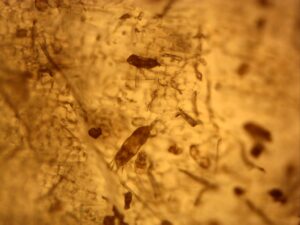
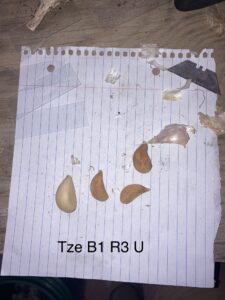
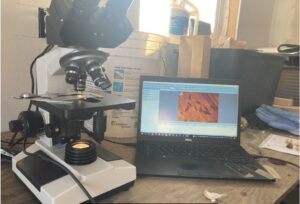
The most important observation from these trials was that, as is often the case, use of biological controls is complicated. The complications with this project begin with the observation that mite levels are generally low enough when garlic enters storage that producers may not be able to find any at all, even if enough are present to eventually cause an outbreak. Detection may require extensive destructive sampling since mites reside on the inside of the wrapper leaves. This leaves growers having to decide whether to make a relatively costly application without knowing if they have a problem.
Timing the application of biocontrols is the next complication we encountered. We designed the experiment to apply Stratiolaeps as garlic was entering storage with the idea that they could immediately predate any mites that were present in the garlic. However, we found that Stratiolaeps were not effective in controlling a low-level infestation of mites. This may indicate that they died out before finding mites to feed on, leaving the few remaining A. tulipae to multiply unfettered. Stratiolaeps were more effective in the garlic which appears to have had higher initial levels of A. tulipae, but were not effective enough to entirely eradicate the mite problem. The level of damage on cloves treated with Stratiolaeps was still unacceptable for seed or food sales.
A final potential complication to the use of Stratiolaeps for mite control is their application in storage. We kept our experimental treatments in organza bags which held the mites in place. If the garlic is stored in vented crates or bins, it isn't clear whether the mites would remain where they were applied. Additionally, the media that the mites come in resembles potting mix, which is not a welcome addition to a bag of garlic being purchased for food or seed. The extra step to remove this media will add additional work and cost.
This study did not lead us to definitively recommend predatory mites for control of A. tulipae in garlic during storage, but it has made it clear that additional research on timing of applications and ways to establish thresholds for applications are warranted.
Our project sought to examine whether the predatory mite Stratiolaeps was an affective biological control for A. tulipae (dry bulb mite) populations which proliferated in storage. With half our sites yielding no mites to control and half yielding conflicting results, our data are largely inconclusive. However, the conflicting results may arise from population dynamics which warrant additional study, ideally in a lab setting where predator and prey interactions could be more closely monitored. Additional research could yield useful information about timing the release of predatory mites and about how to establish a threshold at which applications may be effective. Additional studies of population dynamics at different temperatures may also be quite useful, since growers store garlic at a variety of temperatures and relative humidities.
Education & Outreach Activities and Participation Summary
Participation Summary:
Articles:
ENYCHP’s Produce Pages (574) and CCE CVP’s VegEDGE (650):
Preliminary results from garlic eriophyid mite control study show some promise
Eriophyid mite control in garlic improves using a multi-pronged approach
Vermont Vegetable and Berry Growers Association Newsletter (700)- did not publish results
Added outreach: study was introduced in article in The Natural Farmer (19,000): TNF Garlic Article Part 2
Winter meeting presentations:
NOFA-NY (100 attendees): garlic was not covered during the conference
New England Fruit and Vegetable Conference (75 attendees): Scheduled for December 2024
New York garlic school (27 attendees): Eriopyid mite discussion as related to Fusarium management.
Vermont Vegetable and Berry Growers Annual Meeting (200 attendees): Garlic was not covered during the conference
Added outreach:
Hudson Valley Garlic festival (75 and 45 attendees during two talks)
Maine Farmer to Farmer Conference: 13 attended
Learning Outcomes
Growers have consistently reported increased awareness of the issue of dry bulbs mites on their garlic, which is significant because prior to this work most growers were not aware that this was an issue at all.
Growers are aware that this is a very challenging issue to manage, and that single control strategies (drying with heat, oil dips at planting, application of predatory mites) are unlikely to yield complete control. Growers understand that using multiple strategies is likely to yield the best results.
As always, growers would like a control measure with more guaranteed outcomes.
Project Outcomes
Because the results are inconclusive, most farms will not use Stratiolaeps mites for control yet. 3 farms committed to trying them in 2024 despite the mixed results because they have tried other control strategies and been unsuccessful.
Mostly, this project pointed to the need for additional research to better understand best practices to use Stratiolaeps for proper control.
As mentioned, this project yielded more questions than answers. It would be very beneficial to have a lab study of populations dynamics of Stratiolaeps and A. tulipifera completed in a way that allowed regular monitoring. This might shed light on proper application timing for most effective control.
I will continue to advocate for a multi-pronged approach to A. tulipifera control, and will continue to increase awareness about the problem in general. The use of predatory mites may be a part of the control strategy, with a clear caveat that results in trial work have varied.
I would be thrilled to see an entomologist pick up this work and provide more of the detailed information we need to be successful.
